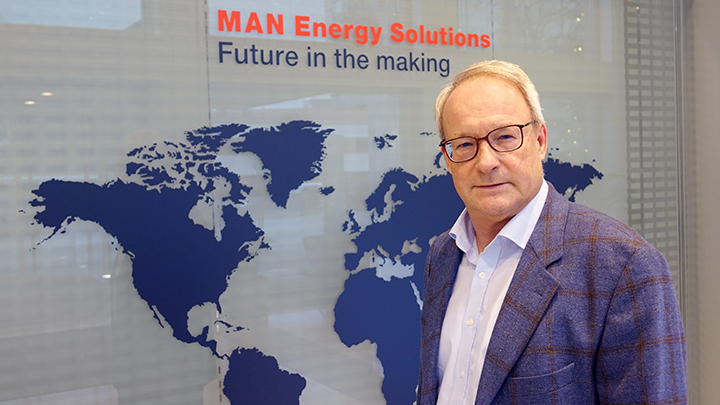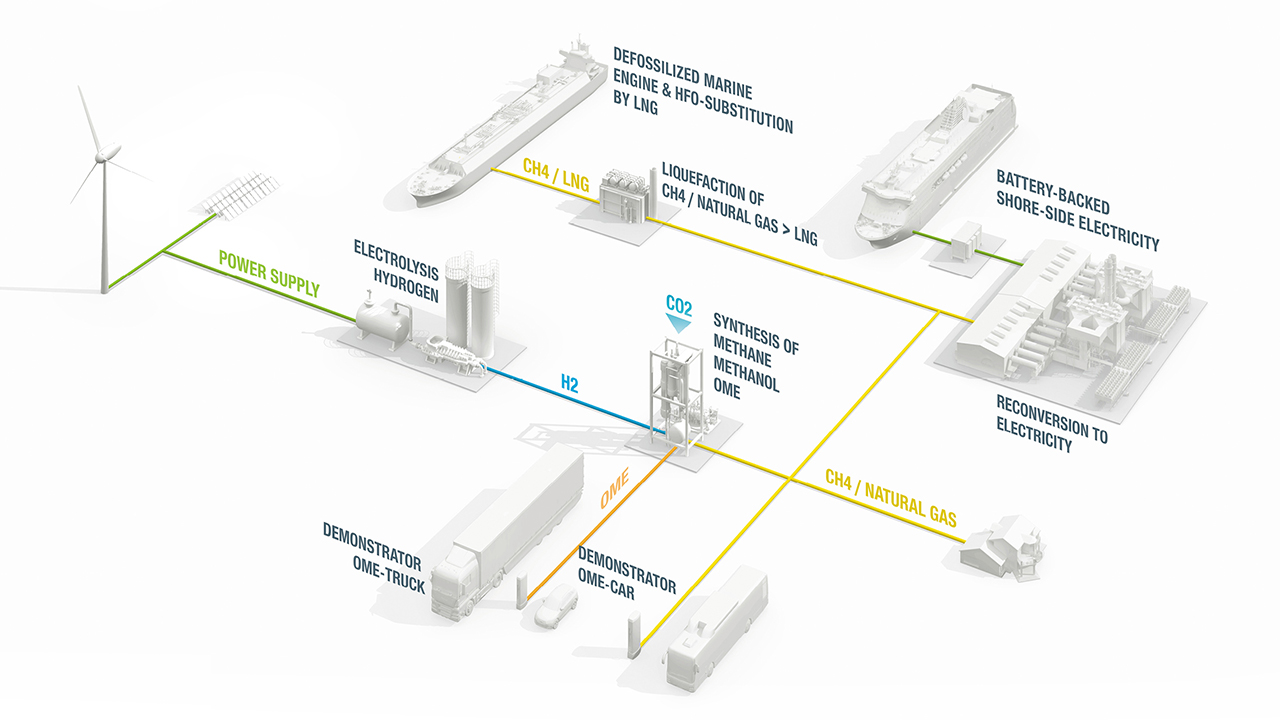Power-to-X is the carbon-neutral energy storage and sector coupling technology of the future
The next ten years are crucial, predict most climate experts. Our actions within this decade will decide whether we are able to reach the ambitious goals of the Paris agreement limiting the global temperature increase to 1.5°C until 2050. But recent studies have shown that G20 nations are currently failing to reach their climate goals.
To get back on track by 2050, a carbon-neutral electricity supply has to be bolstered by a transition to sustainable heat and mobility. Marc Grünewald believes we already have the technology to achieve successful decarbonization in all these sectors. As head of business development and new energies at the Power Unit of MAN Energy Solutions, he ensures that the company’s power technologies are future-proof.
His team turns recent technological innovations into marketable solutions ranging from hybrid and LNG power plants to cutting-edge energy storage like ETES (Electro-Thermal Energy Storage) and Power-to-X. The latter refers to the many possibilities of converting renewable energy, for example, into methane gas (Power-to-Gas) or liquid methanol (Power-to-Liquid). The resulting carbon-neutral synthetic gas can easily be transported through existing pipelines and used in gas-powered engines.

Marc Grünewald, head of business development and new energies at the Power Unit of MAN Energy Solutions
Why do we need an energy storage technology like Power-to-X?
Energy storage is a global issue. In Germany, for example, we produce over 40,000 MW in offshore, solar and wind power, but each year around 5,500 MW of this potential get lost because the grids can't absorb it all. We have to store renewable energy for those times when it is not generated. Next to prevailing pumped hydro storage, a currently vastly expanding energy storage solution is the battery, but a lot of CO2 is created in its overall life cycle. In addition, its weight makes it unsuitable for many applications, for example in the maritime transport sector. To contribute to the environment, we have to make the fuel for propulsion engines carbon-neutral, which brings us to Power-to-X, or more specifically Power-to-Gas. Instead of storing sustainable energy in batteries, we can produce synthetic natural gas (SNG), which can then be used as fuel. That’s a path to a carbon-neutral future we have to explore.

The many possibilities of Power-to-X visualized in an infographic
How does Power-to-Gas work exactly?
Renewable energy that cannot be fed into the grid is used to produce hydrogen and oxygen via electrolysis. Adding CO2 to the hydrogen in a methanation reactor results in methane, a carbon-neutral synthetic gas and very important future energy carrier, perfectly suited for cars and trucks, but also for public transport, and even ships. By using carbon-neutral fuels to power internal combustion engines, we can make a sustainable contribution to decarbonization immediately, using existing infrastructure. Our Power-to-Gas reactor, which has been successfully operating since 2013 in a German Audi plant, is a fantastic example: The SNG is fed to the natural gas grid, supplying Audi customers’ gas powered cars.

The Power-to-Gas reactor built with MAN technology at a German Audi plant
What role does MAN Energy Solutions play in the development of new energy storage technologies?
Energy storage is a very important part of MAN's strategic path towards a decarbonized future. Our goal is to take the concept, which has proven successful at the Audi reactor, to an industrial scale. These aren't just daydreams – we have teams of people here who develop and design these systems and invest money into products and technologies that will be market-ready soon. We already have a 50-MW comprehensive plant solution ready to offer. Our goal is to sell the first plant this year.
What is the future of Power-to-Gas?
The World Energy Council recently estimated a global demand for carbon-neutral synthetic fuels of 10,000-20,000 terawatt hours by 2050, equivalent to 50% of current fossil fuel consumption. To meet that demand, we have to build these facilities on a larger scale in countries that have high potential for solar and wind power – there are huge application potentials in the future. Right now, Power-to-X is where wind energy was 20 years ago. It's carbon-neutral, but also more expensive. This technology needs political support to make it economically attractive for the energy market, taking into account the emission-reducing effect of the resulting fuel and making it more cost-effective by factoring in the carbon price.

Power-to-X – the future energy storage solution for solar and wind power
The efficiency of electrolysis is currently rated 60-65%, but since the technology is gaining in importance, there is a great improvement potential. In future, values of up to 80% are conceivable here.
Power-to-X - Key to successful energy transition
Power-to-X (P2X) combines all available options for the effective and flexible use of surplus power from renewable energies – like using P2X to convert electricity into gaseous or liquid fuels or chemicals for long-haul trucking, shipping, aviation.
By using CO2 emissions as feedstock, the fuels produced also become carbon-neutral. And when it comes to achieving very large ranges and the amounts of energy they require, P2X is an ideal supplement to battery technology.
.jpg?sfvrsn=9b13fb15_2)
Explore more topics
MAN Energy Solutions is now Everllence.
We have adopted a new brand name and moved to a new domain: www.everllence.com. This page will also be relocated there shortly. We are working on shifting all pages to www.everllence.com.
